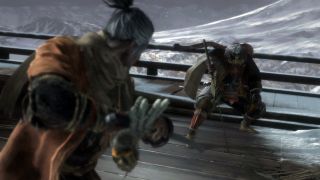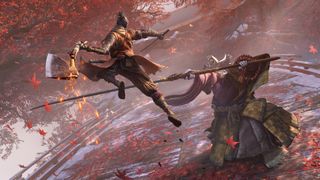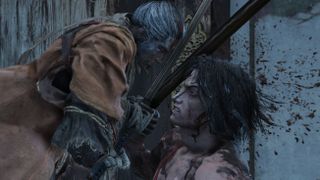Sekiro is a perfect subversion of everything Dark Souls taught me
The changes to Sekiro's combat are easy to understand but difficult to internalize.

Extremely Minor Alert: This article contains mild spoilers about the identity of a few bosses for Sekiro: Shadows Die Twice.
I've never liked a boss in Dark Souls or Bloodborne. I fear all of them, respect most of them, and outright loathe a few of them—but like them? No. They're terrors meant to be endured. Supernatural monstrosities that flail and slam and scream, and the only way I survive is by keeping my shield up and waiting for that split-second opening where I can sneak in a hit. And that's exactly how I approached every boss in Sekiro: Shadows Die Twice, the latest in FromSoftware's very specific (and cruel) blend of action RPGs.
I first encountered "Seven Ashina Spears - Shikibu Toshikatsu Yamauchi" near the Moon View Temple. Almost 20 hours had passed since I last saw this place during Sekiro's brief intro, and Shikibu Toshikatsu Yamauchi was one of the many new enemies who had settled into the area. I found a secret route into the Moon View Temple he guarded and plundered it, so I didn't need to fight him. But where's the fun in that?
Until this point, I had weathered nearly a dozen of Sekiro's minibosses and a few of its proper bosses. I say weathered because, like the bosses from Dark Souls and Bloodborne, every victory felt like pure luck—the equivalent to closing my eyes and waving my sword around and somehow managing to stick someone with it. I never felt in control or adept—a mere shade of the stoic and courageous shinobi I control. Not me, I'm a wimp.
Being a spiritual sequel, Sekiro shares so much DNA with Dark Souls and Bloodborne—but this isn't just a new spin on a familiar formula. Sekiro undermines everything. In facing Yamauchi, this purely optional boss, Sekiro finally drove home the lesson I had been resisting for hours: Forget your instincts. Everything Dark Souls had taught me until now is wrong, and it took a man with a big spear to help me realize it.

Studying the blade
For 10 years, I've played every FromSoftware game abiding by this single, inviolable truth: Play defensively and wait for the opening.
If you haven't yet played Sekiro, the changes it makes to FromSoftware's beloved combat system feel almost insignificant. There's no more stamina meter to fret over as I swing my sword or dodge attacks. That's replaced by a posture meter that fills each time I block an incoming strike. Block too many attacks without a rest and my posture mere will fill and then break, leaving me vulnerable to a hit. But if I time my block perfectly, I'll deflect the blow, taking no posture damage and filling opponent's posture meter instead.
Only after managing this system of stamina and posture can I set up a one-hit kill called a shinobi deathblow. On weaker enemies, even just a single deflection can leave them vulnerable to an instakill, but Sekiro's bosses are made of sterner stuff.
The biggest gaming news, reviews and hardware deals
Keep up to date with the most important stories and the best deals, as picked by the PC Gamer team.
Sekiro's tutorials explained all of this and, honest to god, I thought I had internalized these lessons. But 20 hours in, just before facing Yamauchi for what must have been the 10th time, I couldn't honestly say I was enjoying Sekiro—not like I am now, at least. Whereas every FromSoftware game feels cruel and brutal, Sekiro felt downright malicious. Its enemies were relentless and deadly, rarely allowing a moment to breathe between attacks. I felt like I was playing Dark Souls with no shield and no spells available to even the odds.
Yamauchi himself attacks with such ferocity and dexterity, his spear wheeling about in arcs that are hard to track. Despite his bulk, he leaps and dances like a Cirque de Soleil performer.
But then I squared off against Yamauchi again and told myself one thing: Be aggressive.

Everything changed. This time I didn't give him an inch. I mashed the attack button, ready to block the moment that Yamauchi would deflect my own attack and try to counter. I was ready for that. In that instant, I deflected his counter and countered him back. The big bastard never saw it coming.
Until that moment, I had approached every enemy in Sekiro the same way I would in Dark Souls or Bloodborne. I'd get their attention and let them make the first move. I'd study their attacks and wait for that key moment when they'd overextend and expose themself, and then—and only then—would I strike. That's how you kill a giant alligator with a gaping maw for a tummy, or a giant otter made of lightning. For 10 years, I've played every FromSoftware game abiding by this single, inviolable truth: Play defensively and wait for the opening.
So imagine my shock when Sekiro walks in here like a 24-year-old millionaire life coach, looks me dead in the eyes and says "Nah, dawg, create the opening."
Relentless
Shikibu Toshikatsu Yamauchi is a good teacher, apparently. Patrick Klepek over at Waypoint learned a similar lesson on that exact same boss. But what I love is how that single victory over Yamauchi single-handedly empowered both of us to take on Sekiro's greatest challenges. In the aftermath of that fight, we both took on things that once seemed insurmountable.
For me, that meant returning to the top of Ashina Castle and facing off against Lord Genichiro Ashina—the last boss I'd been trying to beat. It took me nearly 30 tries before I finally beat Genichiro's first phase, but for the first time in any FromSoftware game, I was loving every moment of it. I no longer felt helpless, but capable. The thrill of our back-and-forth duel is a reward in itself. I like Genichiro.

No longer am I fighting new enemies and waiting to let them act first. I am the one who strikes. When they finally deflect one of my attacks, I now intuitively understand the flow of combat and can react without losing the beat. Sekiro's fights are quickly turning into a kind of fatal music—the percussive clang of steel on steel is a tempo that I dictate, not the enemy. I'm the conductor, and Sekiro's enemies dance to the rhythm of my katana.
It's intoxicating in a way that I've never felt in a FromSoftware game. Whenever I beat a boss in Dark Souls, I'd exhale in relief. I'd survived. Barely. But I don't feel like a survivor in Sekiro. I'm a warrior.
Just like that, two of Sekiro's most intimidating bosses fell before me one after the other. I feel godlike.
After talking about this with fellow PCG editor James, who had a similar revelation, we both felt inspired to take on challenges we had long since abandoned. For both of us, that meant killing Lady Butterfly, the final boss of the Hirata Estates area. James fought her first and came back victorious after his first try. Emboldened by his success, I went after her too.
Days earlier, I had spent an evening unsuccessfully trying to defeat Lady Butterfly and barely leaving a scratch. But with my new understanding of Sekiro's own sacred truth, I also beat Lady Butterfly on my next attempt. Then, during a quick break from writing this, I finally downed Genichiro Ashina too (though that took several tries). Two of Sekiro's most intimidating bosses KO'd in one session. I felt godlike.
The best part of FromSoftware's games has been the unspoken dialogue that exists between designer and player. Each trial teaches through punishment and persistence, and we've long laughed at the insidious ways that FromSoftware pulls the rug out from under you when you least expect it—but I've learned to be wary of empty hallways and unmoving corpses. Sekiro is FromSoftware's most audacious prank to date: a complete subversion of its own legacy and the lessons it has taught me along the way. I can't wait to see what other painful lessons Sekiro has in store.
With over 7 years of experience with in-depth feature reporting, Steven's mission is to chronicle the fascinating ways that games intersect our lives. Whether it's colossal in-game wars in an MMO, or long-haul truckers who turn to games to protect them from the loneliness of the open road, Steven tries to unearth PC gaming's greatest untold stories. His love of PC gaming started extremely early. Without money to spend, he spent an entire day watching the progress bar on a 25mb download of the Heroes of Might and Magic 2 demo that he then played for at least a hundred hours. It was a good demo.
Most Popular

